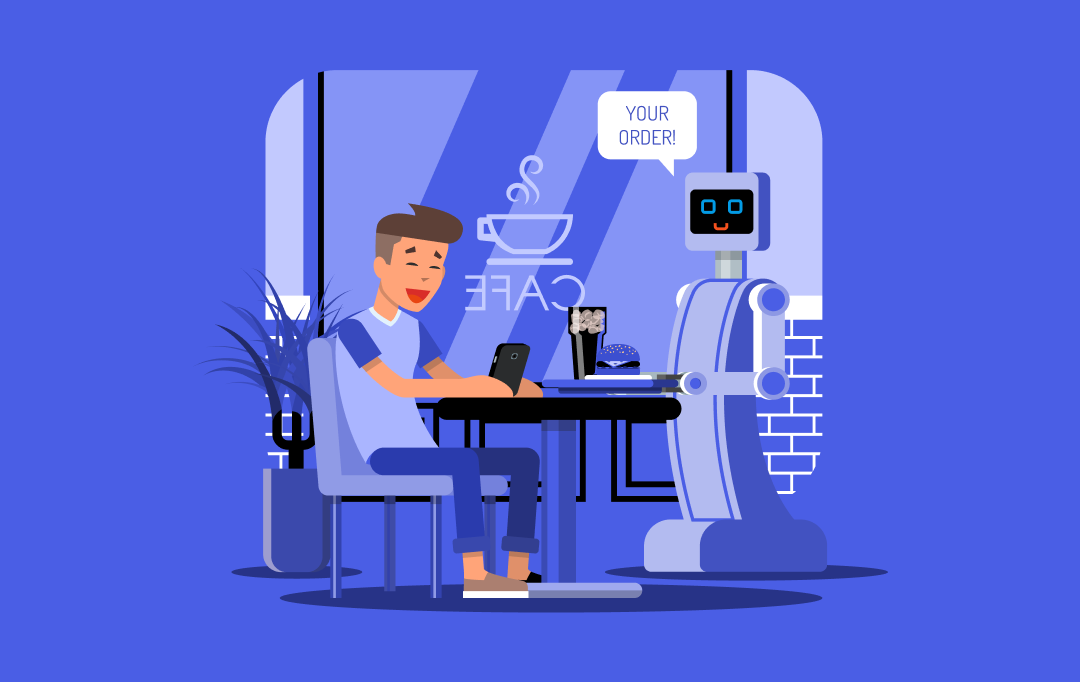10 Real AI Use Cases & Examples in the Restaurant Industry
作者:Chirag Bhardwaj
If you walk into a restaurant today, you might be greeted by a robot, place your order on a screen, or get personalized food recommendations based on what you’ve ordered before. What once felt futuristic is now quietly becoming part of our everyday dining experience, all thanks to AI in restaurants.
Also, artificial intelligence in the restaurant industry goes far beyond just flashy tech like robot waiters or touchscreen menus. The real work is happening at the backend. AI for restaurants is helping them handle everything from taking reservations and predicting food demand to managing inventory and reducing waste.
This growing use of AI in restaurant industry settings is helping businesses operate more efficiently and adapt to changing customer expectations.
But automation in restaurants is not just limited to big chains like McDonald’s or Domino’s. Whether running a small café or scaling up a multi-location AI restaurant, you can use AI tools to keep up with rising costs and labor shortages, while still delivering great service. Whether automating phone calls, scheduling staff, or recommending popular menu items, AI can be a significant helper in the kitchen and front of house.
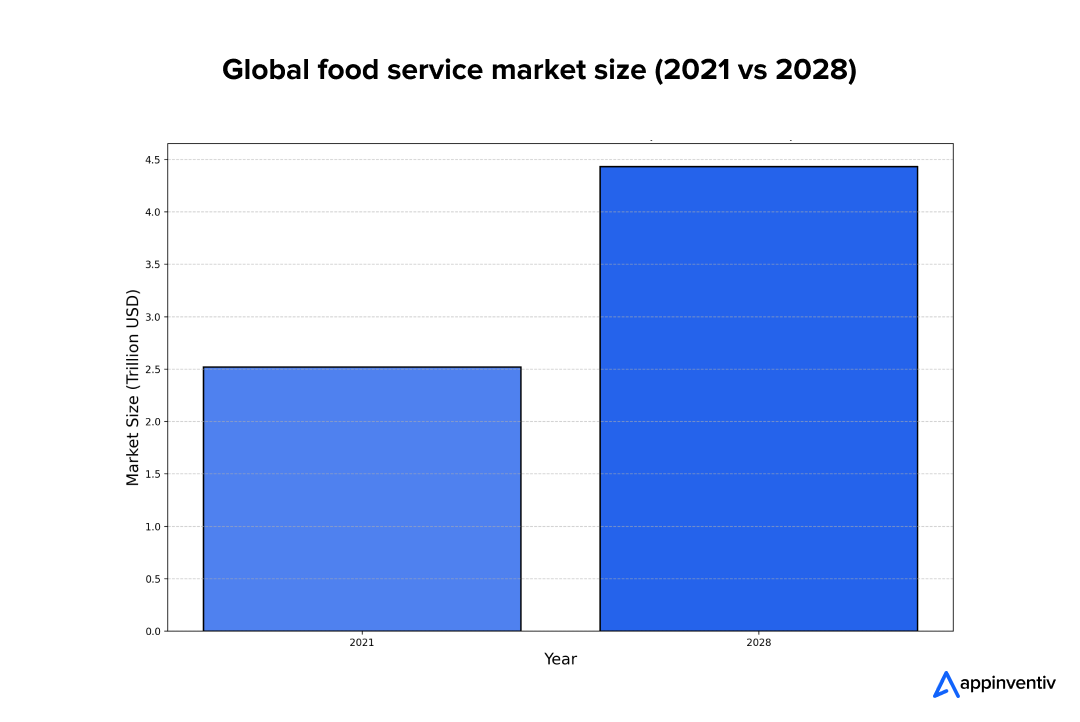
According to Statista, the global food service market was valued at $2.52 trillion in 2021 and is expected to grow to $4.43 trillion by 2028, with a CAGR of 9.9%.
With the industry expanding so quickly, and AI in restaurant industry solutions becoming more accessible, now is the perfect time to explore the benefits of AI in the restaurant industry. In this blog, we’ll walk you through 10 real-life use cases that show how AI is reshaping modern restaurants, along with examples of how leading brands are putting it into action.
Tap into the power of AI in restaurants to thrive in the $2.52 trillion food service industry with our innovative AI development solutions.
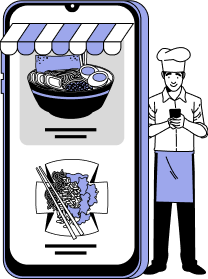
Understanding the AI Restaurant Era
Have you ever opened a food app and thought, “How did it know I wanted tacos and pizza today?” That’s not magic, it’s artificial intelligence quietly working behind the scenes. Big players are going all-in on AI-powered food delivery app development, completely flipping their food service game while droppin’ a killer customer experience.
AI in restaurant industry operations is already transforming the food sector in ways many diners don’t notice. All over the world, from Los Gatos to Nairobi, we’re seeing the rise of “AI restaurants.” At Burgerbots in California, robotic systems can assemble a burger in just 27 seconds.
However, using artificial intelligence in restaurant industry goes far beyond time savings. It can recognize loyal customers, tailor their experience, predict demand, and even help design menus that resonate with local tastes. In quick-service restaurants, an AI-powered QSR solution can make handling rush hours easier, reducing errors, and delivering consistent quality at scale.
Difference Between AI and Machine Learning in Restaurants
AI allows computers to mimic human behavior, like responding to customer voice commands, processing orders, and managing kitchen workflows. But machine learning takes things a step further. It allows restaurant systems to learn from customer data, historical trends, and real-time conditions to optimize future decisions.
Think of how Netflix or Spotify recommends new shows or songs. You get more accurate suggestions the more you use the platform. That same logic is now being applied in restaurants to recommend menu items, predict busy hours, or even suggest when to restock certain ingredients.
AI Adoption & Automation in Restaurants
Restaurants are adopting AI in three major ways:
- Upgraded Legacy Systems: AI is being integrated into core platforms like POS and inventory tools to improve efficiency and minimize food waste.
- New AI-Based Products: Robotic cooks, servers, and dishwashers are gaining attention, especially in high-traffic environments.
- API Integrations: AI capabilities are being embedded into existing systems (like KDS, CRM, and scheduling software) through API partnerships.
Now that we have seen the advantages of AI in restaurants and the major ways it’s been adopted, let’s understand the AI use cases in restaurant industry in detail.
Benefits of AI in Restaurant
Artificial intelligence in restaurants is enabling intelligent operations where it matters most:
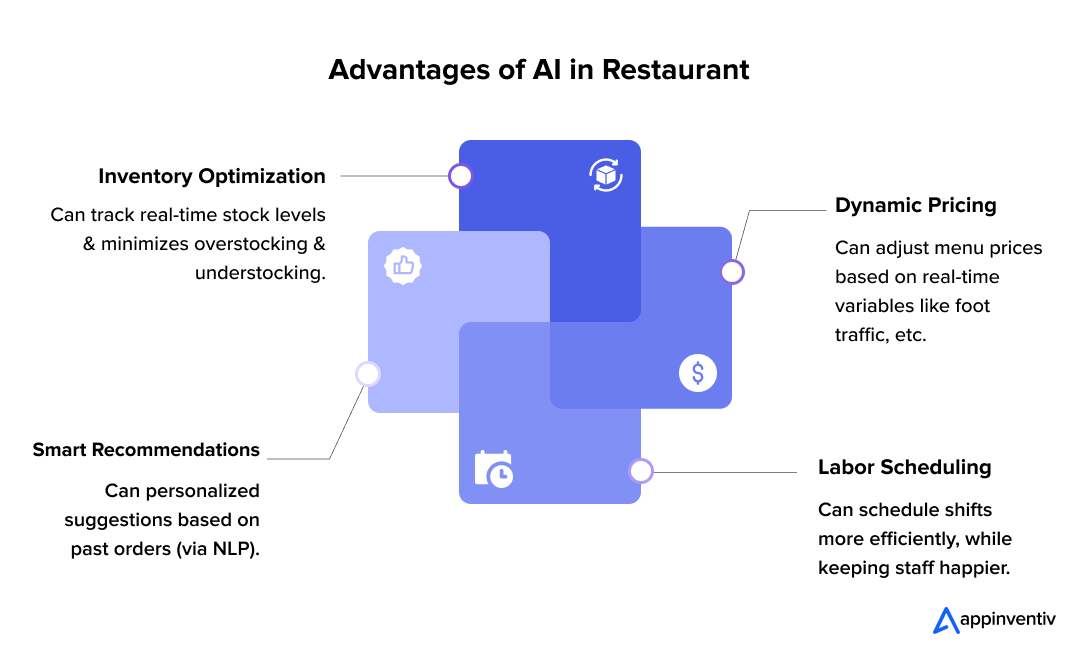
- Inventory Optimization: AI in inventory management can track real-time stock levels, analyze sales trends, and predict demand. This minimizes overstocking and reduces food waste, which are key AI restaurant automation goals.
- Dynamic Pricing: With AI, restaurants can adjust menu prices based on real-time variables like foot traffic, ingredient costs, or weather conditions. This level of flexibility is revolutionizing AI in QSR environments and shaping the modern AI powered restaurant game.
- Labor Scheduling: AI-driven forecasting helps schedule shifts more efficiently, reducing overtime, managing turnover, and keeping staff happier.
- Smart Recommendations: Restaurants can upsell more effectively using machine learning. AI offers personalized suggestions based on past orders, time of day, or the customer’s current mood (via NLP). Building a recommendation system for restaurants can help driving higher average order values.
AI Use Cases in the Restaurant Industry
The integration of AI in restaurants has transformed how the food and beverage sector operates. From predictive analytics and voice ordering to kitchen automation and dynamic pricing, the use of AI in restaurant industry is solving real-world problems. Whether you run a small cafe or an AI powered restaurant chain, the impact of AI is real! So, here are the top 10 AI use cases in restaurant industry, followed by real-life examples.

Personalized Customer Experiences
AI can analyze customer preferences, past orders, and dietary restrictions to offer personalized dining suggestions. Whether recommending dishes based on the weather or offering healthier alternatives, AI can create personalized dining experiences.
Example: A popular QSR chain uses AI solutions for quick service restaurants to track customer preferences through their mobile app. If a customer has ordered vegan dishes previously, the system will automatically recommend plant-based options when they check in. This AI-powered QSR solution might boost repeat visits.
Making Restaurant Reservations Easier
Rather than relying solely on human intuition, AI systems can predict peak times, suggest optimal reservation slots, and even handle waiting lists. This leads to a smoother dining experience for customers while improving operational efficiency during busy hours.
Example: A restaurant uses AI technology and restaurant data to predict when reservations will peak based on local events and past trends. The system suggests the best reservation slots, ensuring that customers are seated efficiently and staff aren’t overwhelmed.
Chatbots for Customer Service and Ordering
Chatbots powered by AI are taking over the customer service and ordering process. Use of AI in restaurants ranges from answering FAQs and processing orders to handling reservations, These bots offer 24/7 support across platforms like WhatsApp, Instagram, and restaurant apps. And, makes it easier for customers to engage with the restaurant anytime, anywhere.
Bonus Read: How Chatbot Development Can Help You Earn $80,000 a Month
Example: Quick service restaurants (QSRs) can use AI in QSR to deploy chatbots across their apps and websites. These bots will allow customers to place orders directly, check allergen information, and even adjust their orders in real-time. Chatbot builds customer engagement, while automating system, reducing human error, and speeding up the ordering process.
Optimizing Back-of-House Workflow
Orders piling up, ingredients needing to be stocked, and temperatures to be monitored can feel like chaos. Automation in restaurants can optimize workflows by automating routine tasks like inventory tracking, order preparation, and even kitchen temperature regulation.
Example: You use AI-powered systems to track inventory in real-time and adjust order preparation tasks. The system predicts the amount of time needed for each dish based on the current kitchen load and employee performance, helping kitchen staff prioritize tasks and ensure timely service, a key strategy for accelerating QSRs with AI.
Customer-Feedback Analysis
AI can analyze customer feedback at scale by reviewing online reviews, social media comments, and survey responses. It can identify patterns, highlight recurring issues, and even suggest actions based on the analysis.
Example: A QSR chain uses AI solutions for quick service restaurants to scan and analyze thousands of customer reviews each month. When feedback about a particular dish starts trending negatively, the system flags it for the chef to review.
Nowadays, AI-powered emotion recognition has transformed the strategies of collecting and interpreting customer feedback to get real-time emotional responses.
These examples of restaurants using AI show how smart feedback loops help keep the restaurant can keep its menu fresh and customers happy.
Reducing Food Waste with Demand Forecasting
Food waste is one of the biggest challenges restaurants face, not just from a cost perspective, but also from an environmental standpoint. An AI powered restaurant can cut down food waste by predicting how much food it’ll actually need each day.
AI for demand forecasting can predict how many guests are likely to dine on any given day and which dishes are most likely to be ordered based on past sales trends. This is one of the most practical applications of AI in restaurant industry, ensuring sustainable operations and smarter inventory prep.
Example: You can use this level of insight to prep ingredients in just the right quantities, enough to meet demand without overstocking. Also, to ensure popular menu items are always available, while reducing spoilage and cutting down on last-minute supply runs.
Dynamic Menu Pricing
AI tools integrate with your POS, inventory system, and even external data sources like local event calendars or weather forecasts. Dynamic pricing allows restaurants to automatically adjust menu prices in real time based on ingredient costs, demand, time of day, or local competition, creating a smarter AI restaurant ecosystem.
Example: The system might slightly increase the price of high-demand dishes during peak hours or weekends, and offer smart discounts during slower periods to boost foot traffic. It can also flag when ingredient prices rise, helping you adjust dish pricing before it cuts into margins.
Automated Food Delivery
Why you need a food delivery app? With more people ordering online than ever, fast and accurate delivery has become a must for restaurants, especially in the quick service restaurant (QSR) space. AI for restaurants can analyze traffic, weather, order volume, and delivery locations in real time to find the fastest delivery routes. It also helps predict how long each order will take and assigns deliveries to the right driver or delivery partner.
Example: You integrated an AI-powered delivery module into their POS system. Now, when an order comes in, the system automatically groups nearby orders, assigns the optimal delivery partner, and updates ETAs in real time for customers and kitchen staff.
Social Media Marketing Automation
If you’re a restaurant owner or developer building digital tools for the food industry, integrating AI into your social media strategy can save time and boost results. AI-powered tools can automate content scheduling, generate engaging posts, and even analyze customer interactions to improve campaign performance over time.
Example: You could use an AI tool like Buffer or Sprout Social with machine learning features that suggest optimal posting times, create personalized promotions based on customer purchase history, and track post performance.
Business Analytics for Smarter Decision-Making
By pulling data from multiple sources like POS systems, reservation logs, delivery apps, social media, and customer feedback, AI restaurant analytics tools can uncover trends, identify performance gaps, and forecast future business outcomes.
Example: By understanding which locations are most profitable or spotting why certain menu items underperform, AI business analytics will help you make faster, data-backed decisions.
Your restaurant deserves an AI upgrade.
Want to see how AI can transform your restaurant’s operations?

If you’re a restaurant owner or decision-maker still wondering how AI can actually make a difference in your day-to-day operations, you’re not alone. It’s one thing to know what the technology can do, but seeing it in action is what really brings it to life. In the next section, we’ll walk you through real examples of how well-known restaurant brands in the U.S. are using AI to solve real problems.
Real-Life Examples of How Restaurants Are Leveraging AI
From cutting food waste with predictive inventory to creating hyper-personalized ordering experiences with voice and vision technologies, artificial intelligence in restaurants is helping the brands solve real business problems while delivering faster, smarter service.
Here are some real-world examples of restaurants using AI to stay ahead of the competition.
Chipotle
Chipotle is using AI to improve kitchen operations and reduce food waste. In select Southern California locations, it’s testing PreciTaste’s AI-based kitchen management system, which predicts how much food needs to be prepped and when to start cooking.
The system uses real-time data to alert staff about ingredient levels, helping reduce over-prepping and improving kitchen efficiency. In another pilot, the brand introduced Chippy a robotic tortilla chip maker powered by Miso Robotics freeing up staff from repetitive tasks and maintaining consistency in flavor and texture.
KFC
KFC, a leading fast-food company having the world’s second-largest restaurant chain has partnered with Appinventiv to developed a smart solution for managing their restaurant deliveries and ops. Thus, Appinventiv developed seven AI-powered mobile apps across the global markets.
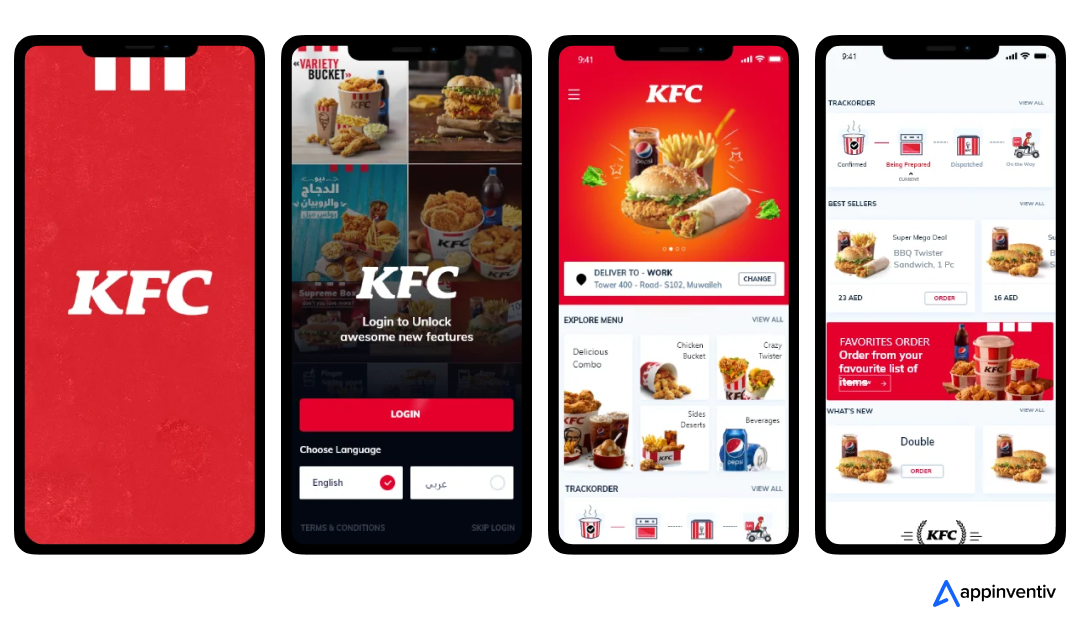
Such applications bear a critical trait for AI-powered personalization. As the apps gather data on user behavior or order history and preferences, they provide personalized meal choices and promotions for greater user interaction and satisfaction. Such personalization caused a 22% boost in conversion rates and 60% more repeated purchases.
Wendy’s
Wendy’s is reimagining the drive-thru with its new generative AI system, Wendy’s FreshAI, built in partnership with Google Cloud. This isn’t just your average voice assistant, it’s designed to understand natural, everyday conversations and manage Wendy’s complex menu with ease.
With over 200 billion possible ways to order a Dave’s Double, FreshAI helps customers get exactly what they want, faster and more accurately. During pilot tests in Columbus, Ohio, it successfully took 86% of orders without help from restaurant staff.
Just Salad
Just Salad launched Salad AI, an AI-powered recipe generator built into its mobile app to make healthy eating more personalized and stress-free. This tool helps customers navigate the menu by recommending customized salads based on their lifestyle (like vegan or climatarian), nutrition goals (like high-protein or low-carb), and flavor preferences.
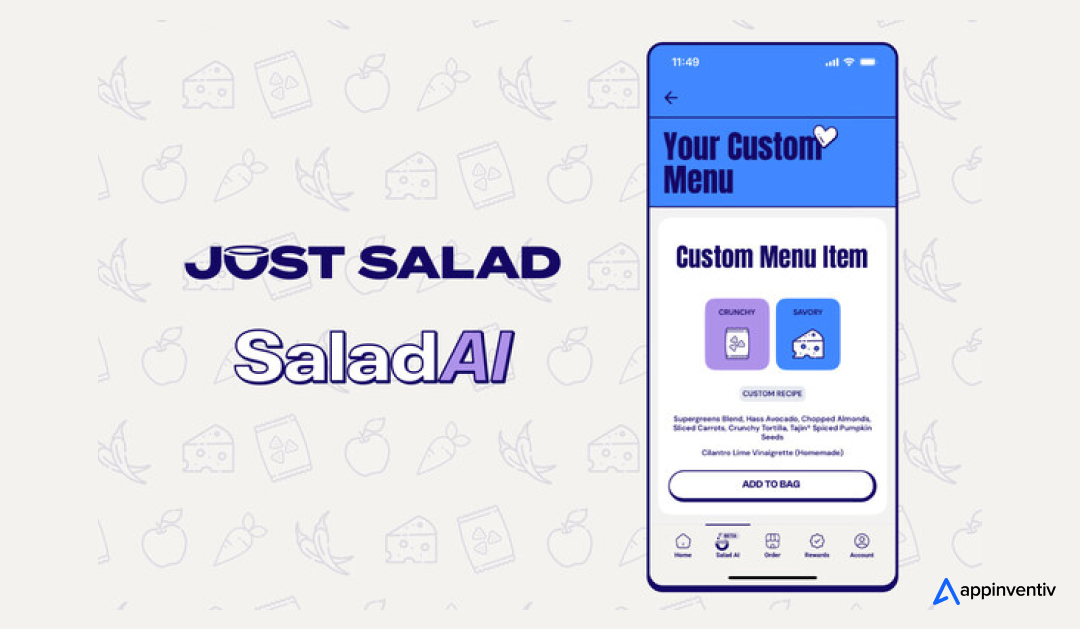
According to Founder & CEO Nick Kenner, “Salad AI goes beyond traditional menu suggestions, it creates a truly personalized dining journey that meets the evolving needs of today’s digital and health-conscious consumers.” The app generates four fully customized salads per user, complete with creative names, selected ingredients, calorie info, and dressing pairings, offering a seamless experience that blends convenience, health, and discovery.
McDonald’s
McDonald’s gone all-in on artificial intelligence in restaurants and is embracing it at scale to streamline operations and improve the customer experience across its 43,000 restaurants globally. One of its first big steps was the 2019 acquisition of Apprente, a voice AI startup specializing in fast-food ordering. Unlike traditional voice systems that convert speech to text, Apprente’s “sound-to-meaning” technology skips transcription entirely, allowing it to understand and process orders directly from speech, even in noisy drive-through environments.
McDonald’s is also exploring computer vision to verify order accuracy in real time, and even developing generative AI virtual managers to handle admin tasks, freeing store managers to focus on team and customer interactions.
As McDonald’s CEO Steve Easterbrook said, “Building our technology infrastructure and digital capabilities are fundamental to our Velocity Growth Plan.”
How our refined UI/UX strategy increased Domino's mobile app conversion rate by 23%

AI Restaurant is the Next Big Thing!
As the restaurant industry continues to evolve, AI in restaurants is set to play an even larger role in shaping its future. The next wave of automation is already here, and restaurants must adopt AI technology and restaurant solutions to thrive in a competitive market. Be it through full-scale AI services and solutions or leveraging AI in Quick Service Restaurants (QSRs), businesses that embrace these advancements will lead the way.
But when it comes to implementing AI solutions in your restaurant, experience matters! Successful AI integration takes more than just good technology. It takes a team that understands the industry inside out.
At Appinventiv, as a top-tier restaurant app development company we have worked with industry leaders like Domino’s, KFC, and Pizza Hut to help them turn these AI possibilities into working, scalable solutions. With over 300+ foodtech projects delivered, a team of 200+ domain experts, and $ 950 M+ in revenue generated for our clients, we’ve seen what works and what doesn’t.
Get in touch with Appinventiv today, and let’s explore how we can bring the power of AI to your business.
FAQs
Q. What are the limitations of AI for restaurants?
A. While AI in restaurants is revolutionizing the food industry, there are still a few limitations of AI for restaurants. These include high upfront costs, dependence on quality data, integration challenges with legacy systems, and the risk of reduced human touch in customer interactions.
Also, small or independent restaurants may struggle to adopt AI due to limited budgets or technical expertise. However, most of these limitations can be mitigated by working with the right AI development partner who understands the unique challenges of the food service industry.
Q. How is McDonald’s using AI?
A. McDonald’s is using AI to make the customer experience quicker and more personal. Think drive-thrus where a friendly voice assistant takes the order, or digital menus that suggest a hot coffee on a cold day. Behind the scenes, AI helps them figure out what to stock, cut down on food waste, and keep the kitchen running like clockwork, all so the meal shows up faster and fresher.
Q. How can AI be used in a restaurant?
A. AI in restaurants personalizes menus, speeds up ordering, automates kitchen workflows, predicts food demand, manages inventory, and even handles customer service through voicebots or smart kiosks. It basically streamlines operations behind the scenes while making the customer experience faster and more personalized up front.
Q. Why should restaurants implement AI?
A. Because it makes everything easier, faster service, smarter operations, and fewer mistakes. It streamlines everything from automating order taking and reservations to tracking inventory, so your team spends less time on routine tasks. Plus, AI gives you real-time insights into your operations, letting you make smarter decisions faster.
关于《10 Real AI Use Cases & Examples in the Restaurant Industry》的评论
暂无评论
发表评论
摘要
相关讨论
- 人工智能应该被政府管制么?
- 在新加坡做面试官的经历 (Interviewer Experience for UI/UX Designer in Singapore)
- Global Recycled Polyester Staple Fiber Market Booms Amid Growing Demand for Sustainable Textiles
- 我的数学基础不好,如果我想成为机器学习和人工智能的专家,我应该怎么学习数学?
- Global Neck Cream and Mask Sales Market Surges with Demand for Targeted Skincare Solutions and Anti-Aging Innovations
